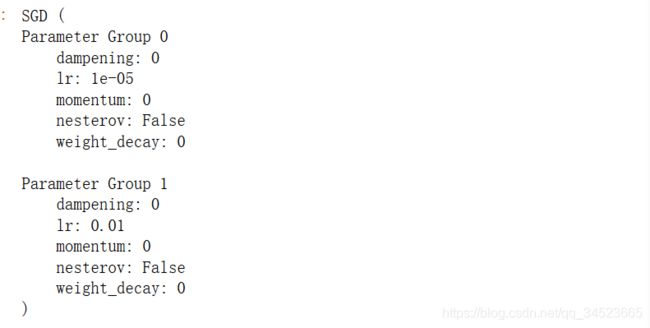Pytorch学习笔记之一
概述
前段时间分享了一些tensorflow2.0入门的笔记,其实在学术界,pytorch的热门程度是高于tensorflow2.0的。不过这些深度学习的框架多是大同小异,所以这里我也更一更torch有关的入门笔记。与tensorflow入门笔记不同,我想按模块来写torch的入门笔记。之前也大概介绍了一下torch的数据加载方式,今天主要讲torch的模型构建。
其实现有的深度学习开源框架基本都是有自动梯度求导的机制,因为自动梯度求导是神经网络能够训练的最重要的一个环节。但是autograd其实抽象程度比较低,用它来实现深度学习模型必然会使用大量的代码。在Pytorch中,torch.nn就提供了神经网络模型的构建模块,这样可以极大减轻构建模型的负担。我们只需要继承nn.Model这个父类,构建自己想要的模型就可以了。
全连接层构建
全连接层是最容易被理解的神经网络层,构建起来也非常简单,所以我们首先构建一个全连接层。
import torch as t
from torch import nn
class Linear(nn.Module): # 继承nn.Module
def __init__(self, in_features, out_features):
super(Linear, self).__init__() # 等价于nn.Module.__init__(self)
self.w = nn.Parameter(t.randn(in_features, out_features))
self.b = nn.Parameter(t.randn(out_features))
def forward(self, x):
x = x.mm(self.w) # x.@(self.w)
return x + self.b.expand_as(x)
layer = Linear(4,3)
input = t.randn(2,4)
output = layer(input)
output
我们继承了nn.Model这个类后,全连接层的类名是Linear,需要使用__init__()函数来初始化一些参数,是输入和输出的神经元数,使用super函数拿到nn.Model的初始化。然后定义了w,b两个参数。Linear类有一个forward方法,执行的就是一个线性变化的操作。最后实例化这个类,传入参数,输入4个神经元,输出3个神经元。输入的是随机初始化的24的矩阵,最后输出。这样一个线性模型就构建成功了。最终的输出应该就是个23的矩阵。我们可以看一下参数情况:
for name, parameter in layer.named_parameters():
print(name, parameter) # w and b
 这里有个线性代数的变换,两个矩阵相乘,如24的矩阵与43的矩阵相乘,结果就是2*3的矩阵。
这里有个线性代数的变换,两个矩阵相乘,如24的矩阵与43的矩阵相乘,结果就是2*3的矩阵。
注意事项:
- 在构造函数__init__中必须自己定义可学习的参数,并封装成Parameter,如在本例中我们把w和b封装成parameter。parameter是一种特殊的Tensor,但其默认需要求导(requires_grad = True)。
- forward函数实现前向传播过程,其输入可以是一个或多个tensor。
- 无需写反向传播函数,nn.Module能够利用autograd自动实现反向传播,这点比Function简单许多。
- 使用时,直观上可将layer看成数学概念中的函数,调用layer(input)即可得到input对应的结果。它等价于layers.call(input),在__call__函数中,主要调用的是 layer.forward(x),另外还对钩子做了一些处理。所以在实际使用中应尽量使用layer(x)而不是使用layer.forward(x),
- Module中的可学习参数可以通过named_parameters()或者parameters()返回迭代器,前者会给每个parameter都附上名字,使其更具有辨识度。
多层感知机
class Perceptron(nn.Module):
def __init__(self, in_features, hidden_features, out_features):
nn.Module.__init__(self)
self.layer1 = Linear(in_features, hidden_features) # 此处的Linear是前面自定义的全连接层
self.layer2 = Linear(hidden_features, out_features)
def forward(self,x):
x = self.layer1(x)
x = t.sigmoid(x)
return self.layer2(x)
perceptron = Perceptron(3,4,1)
for name, param in perceptron.named_parameters():
print(name, param.size())
这里我们传入多了一个变量,有输入输出的神经元,还有中间隐层的神经元。全连接层调用了上面的Linear类。然后我们使用forward方法,通过两个函数来构建层与层之间的关系。
参数情况:
 注意事项
注意事项
- 对于类似self.param_name = nn.Parameter(t.randn(3, 4)),命名为param_name
- 对于子Module中的parameter,会其名字之前加上当前Module的名字。如对于self.sub_module = SubModel(),SubModel中有个parameter的名字叫做param_name,那么二者拼接而成的parameter name 就是sub_module.param_name。
常用神经网络层
图像相关
图像相关层主要包括卷积层(Conv)、池化层(Pool)等,这些层在实际使用中可分为一维(1D)、二维(2D)、三维(3D),池化方式又分为平均池化(AvgPool)、最大值池化(MaxPool)、自适应池化(AdaptiveAvgPool)等。而卷积层除了常用的前向卷积之外,还有逆卷积(TransposeConv)。下面举例说明一些基础的使用。
我们先找一个图片,就用经典的lena,把图片先处理成张量数据。
from PIL import Image
from torchvision.transforms import ToTensor, ToPILImage
to_tensor = ToTensor() # img -> tensor
to_pil = ToPILImage()
lena = Image.open('imgs/lena.png')
lena
# 输入是一个batch,batch_size=1
input = to_tensor(lena).unsqueeze(0)
# 锐化卷积核
kernel = t.ones(3, 3)/-9.
kernel[1][1] = 1
conv = nn.Conv2d(1, 1, (3, 3), 1, bias=False)
conv.weight.data = kernel.view(1, 1, 3, 3)
out = conv(input)
to_pil(out.data.squeeze(0))
pool = nn.AvgPool2d(2,2)
list(pool.parameters())
out = pool(input)
to_pil(out.data.squeeze(0))
除了卷积跟池化层,常用的还有BatchNorm,Dropout层等。
BatchNorm层:
# 4 channel,初始化标准差为4,均值为0
bn = nn.BatchNorm1d(4)
bn.weight.data = t.ones(4) * 4
bn.bias.data = t.zeros(4)
bn_out = bn(h)
# 注意输出的均值和方差
# 方差是标准差的平方,计算无偏方差分母会减1
# 使用unbiased=False 分母不减1
bn_out.mean(0), bn_out.var(0, unbiased=False)
dropout使用:
# 每个元素以0.5的概率舍弃
dropout = nn.Dropout(0.5)
o = dropout(bn_out)
o # 有一半左右的数变为0
激活函数
常见的激活函数也是可以使用nn直接调用。
relu = nn.ReLU(inplace=True)
input = t.randn(2, 3)
print(input)
output = relu(input)
print(output) # 小于0的都被截断为0
# 等价于input.clamp(min=0)
这里的inplace为True时,模型会把输出直接覆盖输入。但是一般不要使用inplace操作,避免不必要的麻烦。
与tensorflow2类似,Pytorch中也是可以使用Sequential这种些话构建模型:
# Sequential的三种写法
net1 = nn.Sequential()
net1.add_module('conv', nn.Conv2d(3, 3, 3))
net1.add_module('batchnorm', nn.BatchNorm2d(3))
net1.add_module('activation_layer', nn.ReLU())
net2 = nn.Sequential(
nn.Conv2d(3, 3, 3),
nn.BatchNorm2d(3),
nn.ReLU()
)
from collections import OrderedDict
net3= nn.Sequential(OrderedDict([
('conv1', nn.Conv2d(3, 3, 3)),
('bn1', nn.BatchNorm2d(3)),
('relu1', nn.ReLU())
]))
print('net1:', net1)
print('net2:', net2)
print('net3:', net3)
循环神经网络
t.manual_seed(1000)
# 输入:batch_size=3,序列长度都为2,序列中每个元素占4维
input = t.randn(2, 3, 4)
# lstm输入向量4维,隐藏元3,1层
lstm = nn.LSTM(4, 3, 1)
# 初始状态:1层,batch_size=3,3个隐藏元
h0 = t.randn(1, 3, 3)
c0 = t.randn(1, 3, 3)
out, hn = lstm(input, (h0, c0))
out
我们输入维度是 234,LSTM的输入为4维,3个单元,只有一层。这里的batch_size为3,那么输入之后的维度应该是233这样的格式。

t.manual_seed(1000)
input = t.randn(2, 3, 4)
# 一个LSTMCell对应的层数只能是一层
lstm = nn.LSTMCell(4, 3)
hx = t.randn(3, 3)
cx = t.randn(3, 3)
out = []
for i_ in input:
hx, cx=lstm(i_, (hx, cx))
out.append(hx)
t.stack(out)
自然语言处理
LSTM在自然语言处理中非常常见。此外,词向量也是非常重要的一环。Pytorch也提供了Embedding层,用于将文本转换成向量,便于模型处理。`
# 有4个词,每个词用5维的向量表示
embedding = nn.Embedding(4, 5)
# 可以用预训练好的词向量初始化embedding
embedding.weight.data = t.arange(0,20).view(4,5)
input = t.arange(3, 0, -1).long()
output = embedding(input)
output
这里我们没有预训练,所以使用生成了一个45的向量表,将输入的三个字符嵌入成35的形式。
损失函数
# batch_size=3,计算对应每个类别的分数(只有两个类别)
score = t.randn(3, 2)
# 三个样本分别属于1,0,1类,label必须是LongTensor
label = t.Tensor([1, 0, 1]).long()
# loss与普通的layer无差异
criterion = nn.CrossEntropyLoss()
loss = criterion(score, label)
loss
优化器
我们首先定义一个网络:
class Net(nn.Module):
def __init__(self):
super(Net, self).__init__()
self.features = nn.Sequential(
nn.Conv2d(3, 6, 5),
nn.ReLU(),
nn.MaxPool2d(2,2),
nn.Conv2d(6, 16, 5),
nn.ReLU(),
nn.MaxPool2d(2,2)
)
self.classifier = nn.Sequential(
nn.Linear(16 * 5 * 5, 120),
nn.ReLU(),
nn.Linear(120, 84),
nn.ReLU(),
nn.Linear(84, 10)
)
def forward(self, x):
x = self.features(x)
x = x.view(-1, 16 * 5 * 5)
x = self.classifier(x)
return x
net = Net()
所有的优化方法都是继承基类optim.Optimizer。
from torch import optim
optimizer = optim.SGD(params=net.parameters(), lr=1)
optimizer.zero_grad() # 梯度清零,等价于net.zero_grad()
input = t.randn(1, 3, 32, 32)
output = net(input)
output.backward(output) # fake backward
optimizer.step() # 执行优化
# 为不同子网络设置不同的学习率,在finetune中经常用到
# 如果对某个参数不指定学习率,就使用最外层的默认学习率
optimizer =optim.SGD([
{'params': net.features.parameters()}, # 学习率为1e-5
{'params': net.classifier.parameters(), 'lr': 1e-2}
], lr=1e-5)
optimizer
special_layers = nn.ModuleList([net.classifier[0], net.classifier[3]])
special_layers_params = list(map(id, special_layers.parameters()))
base_params = filter(lambda p: id(p) not in special_layers_params,
net.parameters())
optimizer = t.optim.SGD([
{'params': base_params},
{'params': special_layers.parameters(), 'lr': 0.01}
], lr=0.001 )
optimizer
对于如何调整学习率,主要有两种做法。一种是修改optimizer.param_groups中对应的学习率,另一种是更简单也是较为推荐的做法——新建优化器,由于optimizer十分轻量级,构建开销很小,故而可以构建新的optimizer。但是后者对于使用动量的优化器(如Adam),会丢失动量等状态信息,可能会造成损失函数的收敛出现震荡等情况。
# 方法1: 调整学习率,新建一个optimizer
old_lr = 0.1
optimizer1 =optim.SGD([
{'params': net.features.parameters()},
{'params': net.classifier.parameters(), 'lr': old_lr*0.1}
], lr=1e-5)
optimizer1
# 方法2: 调整学习率, 手动decay, 保存动量
for param_group in optimizer.param_groups:
param_group['lr'] *= 0.1 # 学习率为之前的0.1倍
optimizer
nn.functional模块
神经网络中的多数函数都会在nn.functional中有对应的。nn.Model实现的是layers的一个特殊的类,可以自动提取可学习的参数。functional是纯函数。
我们使用两种方法都定义模型:
input = t.randn(2, 3)
model = nn.Linear(3, 4)
output1 = model(input)
output2 = nn.functional.linear(input, model.weight, model.bias)
output1 == output2
b = nn.functional.relu(input)
b2 = nn.ReLU()(input)
b == b2
 我们看到这种情况下二者是相同的。那我们怎么选择两种方式呢?如果像激活层,池化层这种没有可学习的参数,就可以用functional,其他尽量使用model类。
我们看到这种情况下二者是相同的。那我们怎么选择两种方式呢?如果像激活层,池化层这种没有可学习的参数,就可以用functional,其他尽量使用model类。
from torch.nn import functional as F
class Net(nn.Module):
def __init__(self):
super(Net, self).__init__()
self.conv1 = nn.Conv2d(3, 6, 5)
self.conv2 = nn.Conv2d(6, 16, 5)
self.fc1 = nn.Linear(16 * 5 * 5, 120)
self.fc2 = nn.Linear(120, 84)
self.fc3 = nn.Linear(84, 10)
def forward(self, x):
x = F.pool(F.relu(self.conv1(x)), 2)
x = F.pool(F.relu(self.conv2(x)), 2)
x = x.view(-1, 16 * 5 * 5)
x = F.relu(self.fc1(x))
x = F.relu(self.fc2(x))
x = self.fc3(x)
return x
上面可以看出来,自己定义一些层的参数比较麻烦:
class MyLinear(nn.Module):
def __init__(self):
super(MyLinear, self).__init__()
self.weight = nn.Parameter(t.randn(3, 4))
self.bias = nn.Parameter(t.zeros(3))
def forward(self):
return F.linear(input, weight, bias)
初始化策略
如果不继承Model,当我们使用parameter时,初始化策略就显得很重要,好的初始化能够加快模型收敛,不好的初始化可能会导致模型瘫痪。
# 利用nn.init初始化
from torch.nn import init
linear = nn.Linear(3, 4)
t.manual_seed(1)
# 等价于 linear.weight.data.normal_(0, std)
init.xavier_normal_(linear.weight)
# 直接初始化
import math
t.manual_seed(1)
# xavier初始化的计算公式
std = math.sqrt(2)/math.sqrt(7.)
linear.weight.data.normal_(0,std)
# 对模型的所有参数进行初始化
for name, params in net.named_parameters():
if name.find('linear') != -1:
# init linear
params[0] # weight
params[1] # bias
elif name.find('conv') != -1:
pass
elif name.find('norm') != -1:
pass






